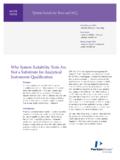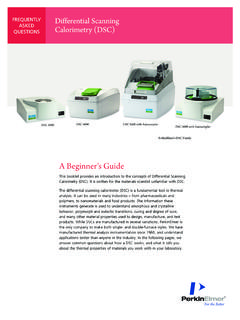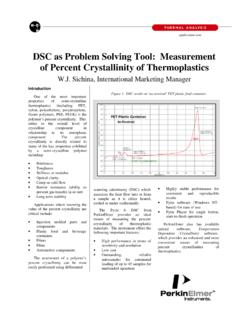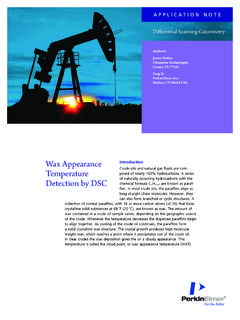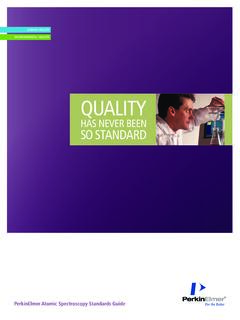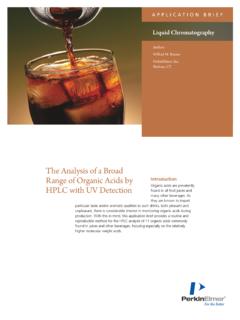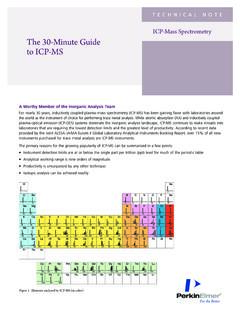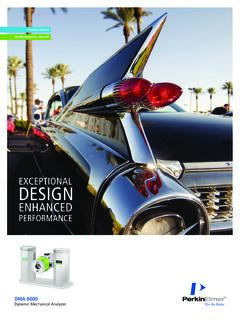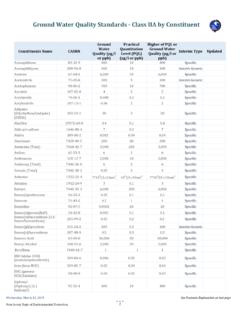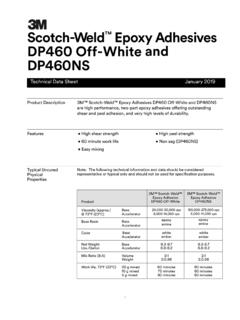Transcription of An Introduction To Headspace Sampling In Gas ...
1 AN Introduction TO Headspace Sampling IN GAS CHROMATOGRAPHYFUNDAMENTALS AND THEORY Andrew TiplerChromatography Research and Technology Manager PerkinElmer, Inc. 2 Introduction 3 Fundamental Theory of Equilibrium Headspace Sampling 3 Volatile Analytes in a Complex Sample 3 Partition Coefficients 4 Phase Ratio 5 Vapor Pressures and Dalton s Law 6 Raoult s Law 7 Activity Coefficients 7 Henry s law 8 Putting It All Together 9 Effect of Sample Volume 9 Effect of Temperature 10 Effect of Pressure 11 Effect of Modifying the Sample Matrix 12 Effect of the Equilibration Time 12 Specialized HS Injection Techniques 13 The Total Vaporization Technique 13 The Full Evaporation Technique 14 Multiple Headspace Extraction 15 Transferring the Headspace Vapor to the GC Column 17
2 Injection Time and Volume 17 Manual Syringe Injection 18 Automated Gas Syringe Injection 18 Valve Loop Injection 20 Pressure Balanced Sampling 20 Direct Connection 20 Split Injector Interface 22 Split Injector Interface with Zero Dilution Liner (ZDL) 23 Improving Detection Limits 24 Sample Stacking On Column 24 On-Column Cryofocusing 25 Dynamic Headspace Sampling 26 Headspace Trap Sampling 27 Solid Phase MicroExtraction (SPME) 30 Conclusion 33 References 33 Glossary 34 Table of ContentsAn Introduction to Headspace Sampling in Gas Introduction to Headspace Sampling in Gas ChromatographyIntroductionThis document is intended to provide the newcomer to Headspace Sampling with a concise summary of the theory and principles of this exciting technique.
3 Enough information is included here for the user to understand the basic concepts and relationships in HS Sampling to apply during method development and interpretation of data. Although emphasis is given to the PerkinElmer TurboMatrix HS systems, the document also covers alternative systems so that it should be useful to all potential users of HS systems. It is not intended to be a comprehensive review of the subject and the reader is directed to an excellent book on this subject by Bruno Kolb and Leslie S. Ettre entitled Static Headspace -Gas Chromatography [1]. This book is available for purchase from PerkinElmer under the part number: Theory of Equilibrium Headspace Sampling Volatile Analytes in a Complex SampleHeadspace Sampling is essentially a separation technique in which volatile material may be extracted from a heavier sample matrix and injected into a gas chromatograph for analysis. To appreciate the principle, let s consider an application that is well suited for Headspace Sampling : perfume.
4 The composition of perfume may be highly complex containing water, alcohol, essential oils etc. If we inject such a sample directly into a typical GC injector and column, we get the chromatogram shown in Figure 1. A lot of time may be wasted in producing this chromatogram by eluting compounds that we have no interest in. Furthermore, many of these compounds may not be suited to gas chromatography and will gradually contaminate the system or even react with the stationary phase in the column so their presence is unwelcome. If we put a sample of this perfume into a sealed vial and heat it to a moderate temperature (say 60 C) for a period of time, what happens to the various molecules in the perfume inside the vial?Consider Figure 2. The more volatile compounds will tend to move into the gas phase (or Headspace ) above the perfume sample. The more volatile the compound, the more concentrated it will be in the Headspace . Conversely, the less volatile (and more GC-unfriendly) components that represent the bulk of the sample will tend to remain in the liquid phase.
5 Thus a fairly crude separation has been achieved. If we can extract some of the Headspace vapor and inject it into a gas chromatograph, there will far less of the less-volatile material entering the GC column making the chromatography Figure 1. Chromatogram from direct injection of a perfume 3. Chromatography of a perfume sample with Headspace Sampling . Figure 2. Movement of perfume molecules within a sealed and heated cleaner, easier and faster. A Headspace Sampling system automates this process by extracting a small volume of the Headspace vapor from the vial and transferring it to the GC column. Figure 3 shows a chromatogram produced from a Headspace sample taken from the same sample of perfume that produced Figure Introduction to Headspace Sampling in Gas ChromatographyPartition CoefficientsThe previous description is simplified. In practice, the migration of compounds into the Headspace phase does not just depend on their volatility but more on their affinity for the original sample phase.
6 Furthermore, if the contents inside the sample vial are left long enough, the relative concentrations of a compound between the two phases will reach a steady value (or equilibrium). For every compound, there is a thermodynamic energy associated with its presence in the Headspace phase and in the liquid phase. These thermodynamic properties dictate how the molecules will ultimately distribute themselves between the two phases. The most convenient way of representing this distribution is through the partition coefficient (also known as the distribution ratio), partition coefficient is proportional to the ratio of the concentration of molecules between the two phases when at equilibrium as shown in Equation 1. Where:K is the partition coefficient of a given compound between sample (liquid) phase and the gas ( Headspace ) phase CS is the concentration of that compound in the sample (liquid) phaseCG is the concentration of that compound in the gas ( Headspace ) phaseK =CSCGNote that compounds with a high value for K will favor the liquid phase whereas compounds with a low K will favor the Headspace phase.
7 As we want to analyze the Headspace phase, we want to ensure that the values of K for the analytes are much lower than that of unwanted components in the sample matrix. The value of K will be dependent on both the compound and the sample matrix and it will also be strongly affected by that this relationship will only apply when the contents in the sample vial are at equilibrium. Thus if this state is attained, then the analytical results should be precise and predictable. This leads to the more formal title for the technique of Equilibrium Headspace Sampling (sometimes also called Static Headspace Sampling ).It is possible to sample the system when not at equilibrium (and this may be necessary for some samples) but the analytical precision and detection limits may suffer. Table 1: Partition coefficients of various compounds between water and air phases at 60 KDioxane 642 Ethanol 511 Isopropyl alcohol 286n-Butanol 238 Methyl ethyl ketone acetate acetate KToluene ,1,1- trichloroethane 1 shows values of K for a range of compounds in water-air systems at 60 C [2, 3].
8 To further explain the meaning of K, let s look at two extremes in Table 1: ethanol and cyclohexane. A value for K of 511 for ethanol means that there is 511 times the volumetric concentration of ethanol in the liquid than in the Headspace . This is expected because of the significant hydrogen bonding between the alcohol and water hydroxyl groups. On the other hand, cyclohexane, which does not exhibit any significant hydrogen bonding, has a K of which means the opposite is true; there is approx 25 (inverse of ) times higher concentration in the Headspace . In summary, if K is less than 1 then the analyte favors the Headspace while if K greater than 1, the analyte favors the liquid phaseIn practice, this means that it should be easy to use Headspace Sampling to extract light hydrocarbons from water and more difficult to extract alcohols from water this provides the theoretical justification to an observation that is rather intuitive Introduction to Headspace Sampling in Gas ChromatographyPhase RatioOther factors that can affect the concentration of an analyte in the Headspace phase are the respective volumes of the sample and the Headspace in the sealed vial.
9 The concentration of analyte in the sample and the Headspace can be expressed respectively as Equations 2 and mass of compound in the original sample will be the sum of the masses in the two phases at equilibrium as shown in Equation :CS is the concentration of compound in the sample (liquid) phaseCG is the concentration of compound in the gas ( Headspace ) phaseMS is the mass of compound in the sample (liquid) phaseMG is the mass of compound in the gas ( Headspace ) phaseVS is the volume of the sample (liquid) phaseVG is the volume of the gas ( Headspace ) phaseWhere:M0 is the total mass of compound in the original sample before analysis Where:C0 is the concentration of compound in the original sample before analysisWhere: is the phase ratioM0 = MS + MG M0 = C0 VS C0 VS = CS VS + CG VGC0 VS = K CG VS + CG VGCS = K CGMS = CS VS MG = CG VG K =MS VGMG VSK = MSMG =VGVSWhen the vial contents are at equilibrium, Equations 2 and 3 may be substituted into Equation 1 to give Equation 4.
10 The ratio of the two phase volumes may be expressed as the phase ratio as shown in Equation 5. Substituting Equation 5 into Equation 4 gives Equation 6. This equation shows us how the mass of a compound will be distributed through the two phases if we know the phase ratio and the partition 6 shows how the masses will be distributed but for a chromatographic analysis we need to find a relationship that will enable us to relate the GC detector response to the concentration of a compound in the original three compound masses in Equation 7 may be related to the phase concentrations and volumes by Equations 8 to Equations 8 to 10 into Equation 7 gives Equation compound concentrations in each phase may be related to the partition coefficient by Equation 12, which is a re-arrangment of Equation Equation 12 into Equation 11 gives Equation 13CS = 2CG = 14C0 = CG [ K + ]Rearranging Equation 13 gives Equation Introduction to Headspace Sampling in Gas Chromatographyptotal = pi pi = ptotal xG(i)
